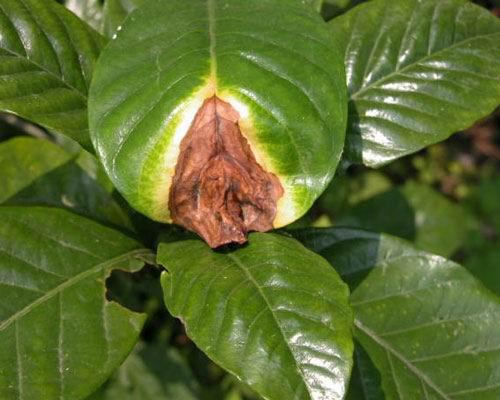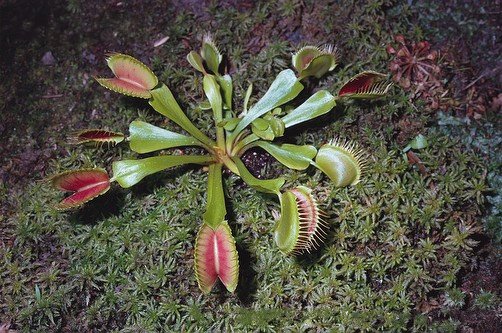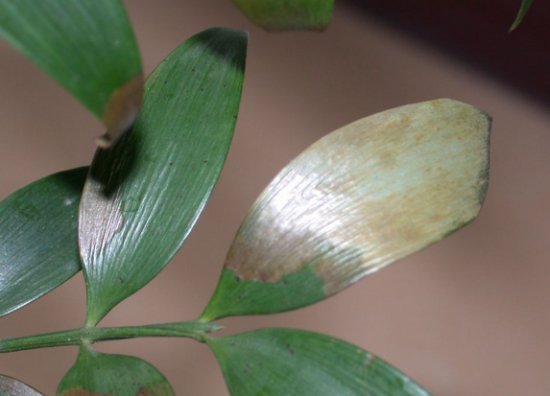Prevention and Control of Diseases and insect pests in Gardenia Culture
Disease and pest control of gardenia culture:
1. Anthracnose of gardenia flower
[symptoms] the disease mainly damages the leaves of Gardenia jasminoides. From the leaf tip, leaf edge began to occur, the formation of irregular or nearly round brown spots. Sometimes the whole leaf turns brown, causing the branch to wither or the whole plant to die. Most of the diseases occurred from the lower leaves of the plant. Under moist conditions, there were small black spots on both sides of the leaf, and most of them were on the back of the leaf (conidium on the leaf surface and ascomycete on the back of the leaf).

[occurrence regularity] overwintering with mycelium lurking on diseased leaves. When the temperature and humidity were suitable in the spring of the following year, conidia were produced for infection. The characteristic of the pathogen is that a large number of phenotypes, namely ascomycetes, can also be formed in the growing season. The conditions of high temperature and high humidity are beneficial to the disease. The seedlings of Gardenia jasminoides were transported on the way, and the incidence was high in the hot and humid environment with poor ventilation.
[prevention and control methods]
① agricultural control. Timely removal of diseased fallen leaves, and centralized destruction, reduce watering, as far as possible in the morning, once thoroughly watered.
Chemical control of ②. Spray 1% Bordeaux solution before the disease to prevent and protect the plant. During the onset of the disease, 50% Bao Gong 1000 times or 10% Shi Gao 1000 times, 430g/L Haolik 2500 times, 75% chlorothalonil wettable powder 500 times 800 times, and so on.
two。 Iron deficiency yellowing of Gardenia jasminoides
[symptom] the disease is a whole-plant non-infectious disease. The symptoms are mainly on the tender leaves and shoots. At the beginning, the young shoots, the leaves are light yellow or white, the leaves are thin and small, and the veins are still green. In severe cases, the veins of the leaves are also yellow or white. Eventually the leaves withered. Axillary buds sprout and form many small tufted lateral branches. The internodes of diseased branches were shortened and clusters were formed. When the disease is serious, the whole tree can be yellow-white, the leaf vein is also yellow-white, the top of the tender shoot is scorched, and even withered. Diseased plants are susceptible to frost damage in winter.
[occurrence regularity] in some areas, because the soil contains more carbonate and the soil shows alkaline reaction, the content of soluble iron is low, or due to the excessive leaching of soluble iron in the soil due to Rain Water, or in the soil with heavy soil viscosity and high groundwater level, the normal physiological activities of plant roots are affected, which reduces the ability of roots to absorb iron, and plants lack available iron, which affects the formation of chlorophyll and occurs yellowing.
[prevention and control methods]
① chooses gardenia planting soil scientifically. When choosing gardenia planting soil, try to avoid planting gardenia in alkaline soil, and should not be planted in low-lying places, easy to stagnant water, and old house waste containing more lime, otherwise it will affect the root system development and prone to yellowing.
② fertilized rationally. In alkaline soil, combined with fertilization, physiological acid fertilizers such as ammonium sulfate, ammonium chloride and calcium superphosphate were properly applied to improve the physical and chemical properties of soil and the availability of iron in soil. In the application of organic fertilizer, add appropriate amount of ferrous sulfate mixed application. In human soil, the organic acid produced during the decomposition of organic fertilizer can increase the activity of iron and make the plant easy to absorb.
③ can apply 0.1%-0.2% ferrous sulfate solution or other iron chelate aqueous solution to diseased plants. 25~lOOg is applied to each tree according to the size of the tree. Use 500g per 10m2 in the nursery bed, but do not need to use it again after the leaf color turns green.
Time: 2019-04-18 Click:
- Prev

Is there really a plant that can eat worms?
There are about 300 kinds of plants that can eat insects in the world, and there are more than 30 kinds in our country. Plants that can eat worms are sensitive. Such as the pitcher plant, the front of the leaf has a pocket like a jar, the bottom of the jar flows out of sweet honey, and the mouth of the jar has a lid. When the gluttonous bug climbed into the jar
- Next

Summarize why the leaves of potted flowers turn yellow at 10:00
Summarize why the leaves of potted flowers turn yellow at 10:00. 1, water reasons. Too much watering leads to mildew and rot of the root system, less watering times and dry air. 2. The temperature is too high. When exposed to direct sunlight, it is easy to scorch the tip or edge of the leaf. 3. Lack of light. If you leave it in the shade for a long time, the flowers and leaves will turn yellow.
Related
- Fuxing push coffee new agricultural production and marketing class: lack of small-scale processing plants
- Jujube rice field leisure farm deep ploughing Yilan for five years to create a space for organic food and play
- Nongyu Farm-A trial of organic papaya for brave women with advanced technology
- Four points for attention in the prevention and control of diseases and insect pests of edible fungi
- How to add nutrient solution to Edible Fungi
- Is there any good way to control edible fungus mites?
- Open Inoculation Technology of Edible Fungi
- Is there any clever way to use fertilizer for edible fungus in winter?
- What agents are used to kill the pathogens of edible fungi in the mushroom shed?
- Rapid drying of Edible Fungi

